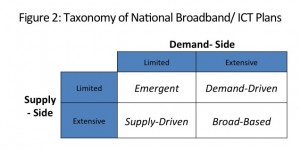































Can broadband lead to economic growth and employment?
This year's edition of the World Economic Forum's Global Information Technology Report (GITR), sponsored in part by Cisco, tackles this critical question and the answer is a decisive 'yes'. Launched today (April 10) in New York, this year's GITR, titled "Growth and Jobs in a Hyperconnected World", details how 144 countries are investing in broadband and IT, and realizing benefits of economic growth and employment.
The top of the report's Networked Readiness Index (NRI) rankings are dominated by northern European, north American and 'Asia Tiger' countries. Several emerging countries, however, are making significant strides: Mexico (progressing from 76thto 63rd) and Colombia (advancing from 73rdto 66th) in Latin America, Turkey (moving from 52ndto 45th) in Central and Eastern Europe, and Kazakhstan (improving twelve positions rom 55thto 43rd) and Georgia (rising from 88thto 65thplace) in the CIS region.
But while these emerging countries experienced gains in their Networked Readiness, other emerging economies are not making progress in narrowing the divide. So what can countries do to boost broadband adoption in order to capture economic growth and employment benefits?
My colleague, John Garrity, and I focus on this question in our GITR chapter examining national broadband and ICT plans. (Chapter 1.3, "Convergent Objectives, Divergent Strategies: A Taxonomy of National Broadband and ICT Plans")
We found that governments seeking to expand broadband adoption emphasize policies that focus on fostering demand as well as broadband supply. (Figure 1)

Broad-based plans are the most comprehensive and incorporate a wide range of policy recommendations on both supply- and demand-side dimensions. Examples ofbroad-basedcountry plans include the United States (2010) and Qatar (2011).
Supply-drivenplans focus on actions to build out infrastructure and increase broadband availability through competition and investment policies; they also include direct action to reach underserved populations. Country examples include Australia (2009), Germany (2009) and the United Kingdom (2010).
Demand-driven plans focus on intensifying the utilization of broadband and ICTs to drive economic growth such as in Morocco (2008) and Poland (2008).
A minority of plans are limited in both the supply- and demand-sides. However, even theseEmergent plans are valuable as they begin a national conversation on broadband.
The taxonomy we developed (see Figure 2) establishes a common language governments can use as they develop their national broadband plan and provides a way to identify gaps in current broadband policy environments. Countries without a cohesive national broadband plan risk losing ground in terms of global competitiveness.

Read more about the GITR 2013 report, sponsored by Cisco, at http://reports.weforum.org/global-information-technology-report-2013/
Watch the unveiling of the GITR 2013 live at: http://new.livestream.com/wef/2013ITReport
Download the Cisco contributed chapter featuring our new taxonomy for national broadband plans: GITR 2013 -chapter 1.3 Convergent Objectives, Divergent Strategies CISCO
 Горячие метки:
Широкополосный доступ к интернету
WEF
Всемирный экономический форум
GITR
Plans
Global Information Technology Report
NRI
Networked Readiness Index
Горячие метки:
Широкополосный доступ к интернету
WEF
Всемирный экономический форум
GITR
Plans
Global Information Technology Report
NRI
Networked Readiness Index